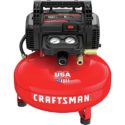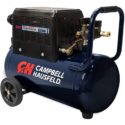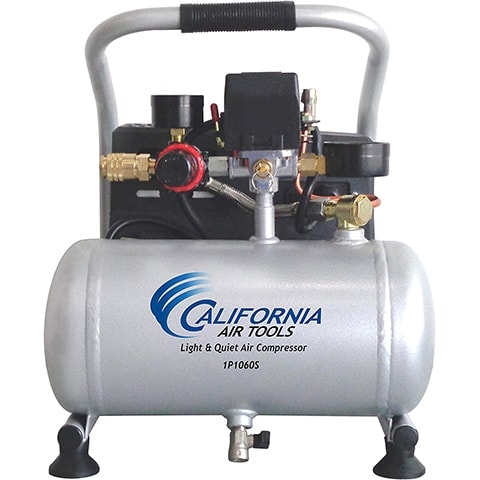10 Best Air Compressors under $200 of 2025 – Reviews & Buyer’s Guide
-

- Last updated:


Getting an air compressor for your workshop is a wise decision if you want to increase your efficiency and reduce the time spent on your projects. You won’t miss your electric tools when you switch, either.
Our guide will walk you through the specs and features of making an informed choice on which air compressor you should buy. We’ll discuss the latest technology and advances in these products, and we’ve included detailed reviews of the 10 best compressors. Although air compressors are expensive, we’ve found several that perform admirably for under $200.

A Quick Comparison of Our Favorites in 2025
| Rating | Image | Product | Details | |
|---|---|---|---|---|
Best Overall
 |
 |
CRAFTSMAN CMEC6150K Air Compressor |
|
CHECK PRICE |
 |
 |
PORTER-CABLE C2002 Air Compressor |
|
CHECK PRICE |
Premium Choice
 |
 |
Campbell Hausfeld Air Compressor w/Shroud |
|
CHECK PRICE |
|
|

|
BOSTITCH BTFP02012 Pancake Air Compressor |
|
CHECK PRICE |
|
|

|
Campbell Hausfeld FP209499AV Air Compressor |
|
CHECK PRICE |
The 10 Best Air Compressors under $200
1. CRAFTSMAN CMEC6150K Air Compressor – Best Overall
The CRAFTSMAN CMEC6150K Air Compressor is an excellent value on several fronts. It is an oil-free unit, which means it’s maintenance-free, too. It has a 6-gallon tank that is more than adequate for most projects. The setup is easy-peasy. It doesn’t take up a lot of space. The compressor measures 16.5” L x 16.5” W x 17.9” H and weighs 30 pounds, making it portable for some individuals.
The unit is suitable for most small tools, with an output of 2.6 cubic feet per minute (CFM) at 90 pounds per square inch (PSI). The maximum PSI is 150, or at least pretty close to it. You can plug it into a 120-volt outlet. The package includes several useful accessories, such as the PVC air hose and a tire gauge. The manufacturer offers a 1-year limited warranty that only covers defects.
- Oil-free motor
- 1-year limited warranty
- Decent selection of useful accessories
- Easy assembly
- Not 150 PSI
2. PORTER-CABLE C2002 Air Compressor
The PORTER-CABLE C2002 Air Compressor is an excellent choice if you only need the unit and not any accessories. It runs on electricity at 2.6 CFM at 90 PSI. It is quite stable with the attached rubber feet. It also has a drain valve to make emptying it easier. The dimensions are 19” L x 19” W x 18” H with a weight of 30 pounds. It’s portable but difficult to move, even with the top handle.
The price is right, but that’s because it doesn’t include accessories. The compressor is oil-free but relatively loud for what it is. However, two people can use it at the same time to make completing your projects faster. However, it does have a relatively short duty cycle, which isn’t unusual for units with these specs. It has a 6-gallon tank.
- Value-priced
- Water drain valve
- Two users at a time
- Expensive optional accessory kit
- Loud
3. Campbell Hausfeld Air Compressor w/Shroud – Premium Choice
The Campbell Hausfeld Air Compressor w/Shroud gets high marks for its versatility. It operates at 2 CFM at 90 PSI and 3.2 CFM at 40 PSI. While it’s electric, it’s also portable with the wheel-and-handle design. The tank is 8 gallons, which is more than we typically see at this price range. The unit is large at 25.5” L x 20” W x 11” H. It weighs in at a whopping 54.9 pounds.
The compressor has an oil-free pump, which makes it quiet to operate indoors. The 90 PSI is a tad low for some pneumatic tools. While we loved the wheels, the size of the unit makes it a bit unwieldy to maneuver. Overall, the product is well-made and built to last. It comes with a 1-year limited warranty. Unfortunately, making a claim isn’t the easiest thing to do.
- Portable
- Versatile
- Shroud protection
- Quiet operation
- Large footprint
- Lower CFM at 90 PSI
4. BOSTITCH BTFP02012 Pancake Air Compressor
The BOSTITCH BTFP02012 Pancake Air Compressor is another corded electric model that you can use indoors with no worries of fumes. Its size is decent for smaller areas at 17” L x 17” W x 19.25” H. The 6-gallon unit comes in at 31 pounds. The specs are in line for smaller jobs using less powerful tools at 2.6 SCFM at 90 PSI. It is also oil-free.
The noise level is a bit higher at 80 dBA for a product of its type. Most that we reviewed hovered around 70 dBA. However, it’s not outrageous by any means. Two people can use it simultaneously, which is always a plus.
- Affordably priced
- 1-year limited warranty
- Hassle-free operation
- Loud
- No accessories
5. Campbell Hausfeld FP209499AV Air Compressor
The Campbell Hausfeld FP209499AV Air Compressor is a product designed for smaller tools where you don’t need a lot of muscle. That’s evident with the maximum PSI and CFM. It’s okay for inflating tires, but not a lot more. That makes it an expensive tool in terms of versatility. On the positive side, it includes useful accessories, such as the air hoses. It also has a small footprint.
The compressor is lightweight, weighing only 21 pounds. Its dimensions are 15.7” L x 7.9” W x 19.6” H. However, it has a decent duty cycle of 75%, which suits its use. At that rate, you can get a lot of work done. While it’s oil-less, it’s louder than we would prefer. Nevertheless, it’s a reasonable option for beginners. It comes with a 1-year limited warranty.
- Accessories included
- Lightweight
- Small tank size
- Low maximum PSI
6. DEWALT DWFP55126 Pancake Air Compressor
The DEWALT DWFP55126 Pancake Air Compressor is another versatile product that runs at 2.6 SCFM at 90 PSI and 3.7 at 40 PSI. You can do a lot of things with this compressor. It is oil-free, which cuts down on your maintenance. It has a drain valve to make emptying it easier, and there are also larger rubber feet on the bottom, which improves its stability.
The unit’s dimensions are 17.2” L x 16.6” W x 20.1” H, and it weighs 32 pounds. The noise level is a little higher than comparable products. Unfortunately, there are the occasional quality control issues. It makes it worse because the customer service is less than stellar. It comes with a 1-year limited warranty.
- High maximum PSI
- Drain valve
- Fair compressed air storage
- So-so customer service
7. California Air Tools CAT-1P1060S Air Compressor
The California Air Tools CAT-1P1060S Air Compressor is a decent product for small jobs but falls short for larger ones, given the cost. After all, it only has a 1-gallon tank. On the other hand, it’s portable, with dimensions of 12.5” L x 14.7” W x 14.8” H. While you’d expect it to weigh less, it weighs 20 pounds. However, it’s especially quiet and only as loud as your fridge at 56 dBA.
The compressor delivers 1.2 CFM at 90 PSI, making it appropriate for smaller tools only. However, it’s a decent option if you need one for tasks like inflating and brad nails. It has a small footprint and won’t take up a lot of space. It doesn’t include any accessories, making it an expensive purchase.
- Small footprint
- Quiet operation
- Lightweight
- Small jobs only
- Low HP
8. Senco PC1010 Air Compressor
The Senco PC1010 Air Compressor is another compact model that tries to be more user-friendly with a cushioned handle for portability. It is a corded electric model with dimensions of 14” L x 13” W x 10” H. This one weighs only 20 pounds. It’s also quiet, which is always desirable. However, the Sencot is appropriate only for small jobs since it has a 1-HP motor.
As expected, the compressor is oil-less for maintenance-free usage. That makes it an excellent choice for the hobbyist who doesn’t need a beast to power their tools. It comes with a 1-year warranty.
- Lightweight
- Compact size
- Limited uses
- Expensive for its versatility
- Quality control issues
9. WEN 2202 Portable Vertical Air Compressor
The WEN 2202 Portable Vertical Air Compressor is the only oil-lubricated product on our list. It is a beast at 19.5” L x 17.5” W x 42” H. While large, it is also portable, with wheels and a handle to move it wherever you need power. That’s a good thing because it’s heavy at 86 pounds. The airflow rates are respectable at 3.8 CFM at 90 PSI and 5.0 CFM at 40 PSI.
Unlike the other compressors we reviewed, this one comes with a 2-year warranty instead of the usual 1-year. This product’s learning curve is higher but not unusual, given its type. It’s also loud, which is another downside. However, it’s versatile with its wide CFM/PSI ranges.
- Large tank size
- Portable
- 2-year warranty
- Big footprint
- Heavy
- Expensive
10. Makita MAC210Q Electric Air Compressor
The Makita MAC210Q Electric Air Compressor stands out as an expensive option, given its specs. It has only a 2-gallon tank with a maximum of 135 PSI. It looks like a large model, but its dimensions are 17.5” L x 18.3” W x 14.8” H. It is a corded electric compressor that is oil-free. It’s maintenance-free, but it’s also heavy at 44 lbs.
On the positive side, it’s quiet, which we’d expect from an oil-free compressor. It’s well-made, but we must balance that fact with its weight and portability. It misses the mark on both scores.
- Low amp draw
- Expensive
- Large unit
- Lower max PSI
- Heavy
Buyer’s Guide – Choosing the Best Budget Air Compressor Under $200
Getting an air compressor is an excellent investment for those who want to take their DIY projects to the next level. Tools that you can use with this device are more powerful and efficient than the ones you plug into an outlet. However, there are several things to consider before you take the plunge. The best place to start is with the type of projects you do and what tools you use.
Terms to Know
We’ll start with some specs; the most important are cubic feet per minute (CFM) and pounds per square inch (PSI). The first term describes the amount of air that the compressor provides at a given PSI. The two have an inverse relationship. When one goes up, the other goes down. It’s essential to know the specifications of the tools you typically use to choose a product that can operate them properly.
For example, a small impact wrench will run 2.5–3.5 CFM at 90 PSI. On the other hand, a rotational sander can require up to 12.5 CFM. The other factor to consider is the duty cycle of the compressor. This figure tells you how long you can run it in 10 minutes. If it’s 25% then you can go 2.5 minutes at a stretch.
You may also see a measurement listed as standard cubic feet per minute (SCFM). CFM is a general measurement of airflow. On the other hand, SCFM provides a more accurate estimate because it’s determined under controlled conditions. It is often higher than CFM as a result.
Think about the types of tools you use. This duty cycle is suitable for the stuff you’ll use intermittently, such as a nail gun. However, it can be problematic for something you’ll operate longer times, like a grinder. We suggest using the specs of the one with the highest CFM and adding 50%. If you anticipate adding to your workshop, consider the figures for anything else you might get, too.
Other things to take into account include:
- Kind of compressor
- Gas or electric
- Drive system
- Oil or oil-free
- Tank size
- Accessories
- Warranty/guarantee
Kinds of Air Compressors
We can approach this topic from several angles. You’ll find models that have horizontal or vertical tanks. This feature is often critical if space is a consideration. A vertical unit will take up less real estate. A stacked horizontal one is also a space saver. Another option is a pancake air compressor. The name refers to the shape of the tank, which sits on the bottom.
You must also think about portability. If you have a dedicated workspace, it may not be a dealbreaker. However, size and weight are essential if you take it to a job site. A wheelbarrow air compressor offers an excellent compromise between size and portability. It’s worth considering if you need a more powerful unit.
Gas or Electric
The choice between gas and electricity often rests on two factors: the availability of electricity and the noise level. If you work in the house, the former is a non-issue as long as you have the right outlet. A 120-volt one can handle compressors with about 2 horsepower (HP). A 220-volt outlet can go up to 5 HP. The difference determines the maximum PSI that the compressor can deliver.
An electric compressor offers a game-changing advantage if you primarily work indoors. It’s much quieter and does not produce gasoline fumes. The choice between the two power supplies also plays a role in maintenance. Electric has the edge on this score. On the downside, you must have the juice to run it. The place you’re working must also be dry.
Drive System
Several factors come into play when discussing the type of drive for a compressor. Noise is one valid consideration, depending on where you work. You must also think about portability and cost. We’ll also include lifespan since this tool is a significant investment. The direct-drive models are on the low end of the spectrum.
They are affordable, and if you get one with low rotations per minute (RPM), they are also less noisy. On the downside, those with higher RPM won’t last as long. Air compressors generate a lot of heat, anyway. Ramping up the RPMs is going to take a toll. A belt-drive compressor doesn’t hook up to the engine’s shaft like the previous type. It also runs quieter because it doesn’t spin as fast.
Oil or Oil-Free
Compressors that use oil are often less loud, which gives them a solid advantage over oil-free models. However, there is more maintenance with this type. That can, in turn, affect its lifespan if you’re not diligent about checking the oil level often. They are also messy to use, as the name suggests.
Tank Size
It’s essential to understand that the function of the tank is the storage of compressed air. You’ll have a reliable supply as long as the unit is running, but smaller tanks provide less compressed air. Bear in mind that many products are cast-iron and heavy. Therefore, weighing all these factors with how you plan on using this tool is vital.
Moisture is often an issue with air compressors. To get the most out of your purchase, choose one with a system for dealing with the condensation, whether it’s a drain valve, desiccant, or moisture trap.
Accessories
Many manufacturers beef up the desirability of their products with accessories. However, it is the proverbial double-edged sword. It’s a good thing if they include items you’ll use. It’s also imperative that they are well-made. Nonetheless, it’s essential that they don’t detract from the quality of the air compressor.
At the very least, look for products that have air hoses. It’ll save you a lot of hassle and money in the long run.
Warranty/Guarantee
A money-back guarantee is a must-have in our book. Things happen, such as the infamous quality-control issue. A reputable manufacturer will stand behind their products with a warranty. We prefer air compressors that include at least a 1-year warranty. Our advice is to read the fine print. Make sure that return shipping is covered, too. Even a portable compressor is quite heavy.
Other air-compressor-related guides:
- 30-Gallon Air Compressor Buying Guide
- Which air compressor is best for a budget of $500?
- Ryobi P731 Cordless Air Compressor Kit Review
Conclusion
The CRAFTSMAN CMEC6150K Air Compressor took the top spot in our reviews as the overall best budget air compressor. It is easy to put together, so you can get to work right away. It is well-designed with quality materials. We also liked the fact that it came with useful accessories for some of the most common tasks.
The PORTER-CABLE C2002 Air Compressor was the best value for our money. The pancake body shape and rubber feet give it the stability it needs. The oil-free pump and drain valve make maintenance a piece of cake, too. It’s an excellent choice for the DIYer.
Cheap air compressors have revolutionized DIY projects by bringing more power to the table with more efficient tools. Products in this price range offer a lot of value once you know the features that make a difference in performance. The models on our roundup can make your jobs easier and reduce your work time. That makes the investment worth considering.
Contents














